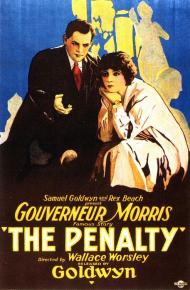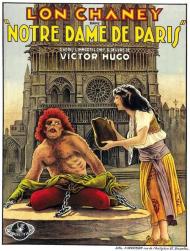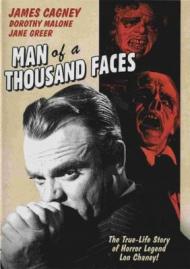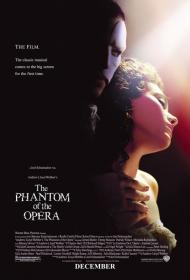Movie Review
The Phantom of the Opera
The Greatest Horror Film Of Modern Cinema!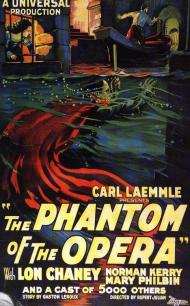
US Release Date: 11-15-1925
Directed by: Rupert Julian, Lon Chaney
Starring▸▾
- Lon Chaney, as
- Erik, The Phantom
- Mary Philbin, as
- Christine Daae
- Norman Kerry, as
- Vicomte Raoul de Chagny
- Arthur Edmund Carewe, as
- Ledoux
- Gibson Gowland, as
- Simon Buquet
- John St. Polis, as
- Comte Philip de Chagny
- Snitz Edwards as
- Florine Papillon
![3.5 star[s] out of 4](http://www.threemoviebuffs.com/static/images/global/featured_gold_stars.png)
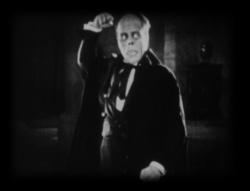
Lon Chaney in The Phantom of the Opera.
The Phantom of the Opera is a gothic horror masterpiece. Its star, Lon Chaney, was called 'The Man of a Thousand Faces' because of his penchant for donning disfiguring disguises and painful make-up. Although he had already made a name for himself in such grotesque roles as Fagin in the 1922 version of Dickens' Oliver Twist and as Quasimodo in The Hunchback of Notre Dame it is for his role as Erik, The Phantom that he will be forever remembered.
The well-known story, set in a Paris opera house, concerns the sudden rise of a beautiful young singer through the intervention of an unknown and mysterious stranger. It is quickly revealed that he is, in fact, the elusive and legendary spectral figure that has haunted the old building for years, known simply as The Phantom. The lovely and innocent Christine, unaware of her benefactor's true identity, follows him down to his hidden lair, five cellars below the Paris streets, where, against his orders (to say nothing of common sense) she snatches off his mask and recoils in horror at his disgusting visage.
She pleads for her life and The Phantom reluctantly agrees to let her perform one last show before returning to be his eternal captive. Of course she immediately plans to betray him by running away with her old boyfriend. Everything builds to a swift and furious climax as the townspeople finally discover the mad fiends lair, chase him to the river and then proceed to beat him to death, before tossing his lifeless corpse into the water.
Many of the classic elements used in the popular Broadway musical were first used in this silent movie. The chandelier that falls on the audience is one and the secret passage through the mirror in Christine's dressing room is another.
Lon Chaney is brilliant in this role. Even when hiding behind the porcelain mask he makes you aware of the suffering Erik has endured. And although he is hideous in appearance and commits horrendous acts, his Phantom is ultimately a sympathetic character.
The directors make great use of shadow and light throughout the movie. The Phantom is often seen as a fleeting image projected on a wall or standing in silhouette. In one scary scene we see the shadow of a man hung, swaying slowly.
This is one of the first true American horror movies and remains one of the all-time best.
![3.5 star[s] out of 4](http://www.threemoviebuffs.com/static/images/global/featured_gold_stars.png)
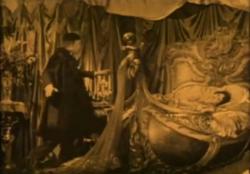
Now that I think about it, Norma Desmond and Erik have a lot more in common than just a bed.
Patrick, how do you see Erik as a sympathetic character? How many people die when he allows the chandelier to crash into the audience? He abducts a girl and gives her lots of gifts. Is that seduction or a lead up to rape? There is nothing about him that earned my sympathy. Being hideous looking does not justify his actions.
Speaking of his looks, the scene where Christine pulls off his mask, (see the picture in Patrick’s review) is a classic. Moments before, she is given a note from Erik stating that she will be safe as long as she does not try to remove his mask. So of course, the first chance she gets, she sneaks up behind him and takes it off. The camera suddenly changes angles and we see his disfigured face in a frightfully dramatic pose.
Not only did I not sympathize with Erik, but I felt little for Christine either. She turns down Raoul’s proposal because she has become famous in the Opera house. The little tart wants fame over his love. However, when she is threatened by Erik she suddenly wants Raoul back. Fickle thy name is woman.
Patrick mentioned some elements that this film established that have been used in later productions. I have never seen the stage production of The Phantom of the Opera but I recall seeing a clip of Michael Crawford, who originated the role of the phantom on Broadway in the Andrew Lloyd Webber musical, in a boat underground. Here Chaney did it first, making the journey to his lair all the more dramatic.
To me, the sets are the real scene stealers of the film. The movie begins in the enormous, ornate opera house with the ballet dancers taking us behind the scenes to a large back stage, where we see gothic images and several levels of dark stone walls. Erik takes Christine, as well as the audience, into the depths of his loneliness through dank tunnels and sewers. He eventually lays Christine in a bed that looks very similar to the one Norma Desmond slept on in Sunset Blvd (1950).
The contrast between the beautiful world of the opera house and the sewers is boldly stated. One scene in the opera house was even made in color. It is during a costume ball and although the color is not brilliant, it still makes the point of how beautiful it all is compared to the dark dreariness of the phantoms' lair.
The Phantom of the Opera is filled with large romantic ideas and imagery, but is actually little more than a horror film about a lonely monster. Had this story taken place in a cheap apartment building where the janitor was in love with the popular girl on the fifth floor, we would not be half invested in the goings on. It is only that it is played out in such a dramatic locale that we find interest in this young superficial girl and her monstrous admirer.
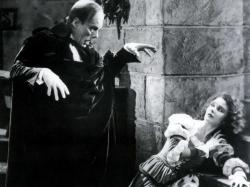
Lon Chaney and Mary Philbin ham it up in The Phantom of the Opera.
I must agree with Eric. In this version of the story, the Phantom is hardly a sympathetic character. His actions, his sanity, his backstory and the ending of the film have been altered from the original novel to make this more of a straightforward horror movie. These alterations probably came about during production, which was troubled. After initial previews, large portions of the film were reshot with a new director, including the new ending. The result is entertaining, but it lacks the emotion of the novel and the musical production.
Despite the large difference in how the Phantom is portrayed, Patrick is right that Andrew Lloyd Webber copied many of the elements of this film for his musical version. Several of the sets are near duplicates of those used here, although I suppose they're both based on the real Paris Opera House, so who's to say who's copying who. Even some of the dialogue on title cards from this film are used word for word in the lyrics to Webber's songs.
As Eric wrote, the sets are elaborate and beautiful. Several scenes were shot in color to show them off, although the only one that survives is the masquerade ball. Amazingly, some of the opera house set still stands in Stage 28 at Universal Studios in Hollywood. It is the oldest surviving structure built specifically for a movie in the world. Hundreds of productions have used it, including most recently, 2011's The Muppets.
It's the acting that is the film's weakest point. Mary Philbin as Christine is a complete ham, overemoting in every scene in the most cliched style of silent film acting. Chaney does a good job for the most part, but he too is guilty of overdramatics, particularly when he seems to be posing dramatically. A few of the smaller parts contain some better acting, including the new Opera House owners and the effeminate stagehand.
This is an enjoyable silent horror film and some of it is remarkable, but the alteration of the Phantom's character keeps it from being perfect.
Photos © Copyright Universal Pictures (1925)

